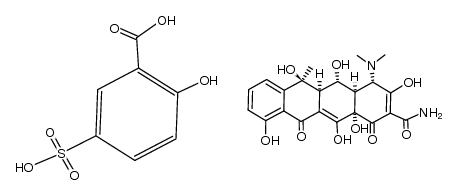2058-46-0
| Name | oxytetracycline hydrochloride |
|---|---|
| Synonyms |
engemycin
mepatar Oxytetracycline Hydrochloride MFCD00135815 oxytetracyclin hydrochloride (4S,4aR,5S,5aR,6S,12aS)-4-(dimethylamino)-1,4,4a,5,5a,6,11,12a-octahydro-3,5,6,10,12,12a-hexahydroxy-6-methyl-1,11-dioxo-2-naphthacenecarboxamide hydrochloride (1:1) oxlopar EINECS 218-161-2 Oxytetracycline Hydrochloride,Can be Used as Secondary Standard oxytetracycline HCl Oxycline terramycin hydrochloride (4S,4aR,5S,5aR,6S,12aS)-4-dimethylamino-1,4,4a,5,5a,6,11,12a-octahydro-3,5,6,10,12,12a-hexahydroxy-6-methyl-1,11-dioxonaphthacene-2-carboxamide hydrochloride otetryn TOXINAL GEOMYCIN tm5 OTC |
| Description | Oxytetracycline hydrochloride is an antibiotic belonging to the tetracycline class. Oxytetracycline hydrochloride potent inhibits Gram-negative and Gram-positive bacteria. Oxytetracycline hydrochloride is a protein synthesis inhibitor and prevents the binding from aminoacil-tRNA to the complex m-ribosomal RNA. Oxytetracycline hydrochloride also possesses anti-HSV-1 activity[1][2][3]. |
|---|---|
| Related Catalog | |
| Target |
Gram-negative and Gram-positive bacteria[1] HSV-1[3] |
| In Vitro | Oxytetracycline is an important member of the bacterial aromatic polyketide family, which is a structurally diverse class of natural products. Oxytetracycline is synthesized by a type II polyketide synthase that generates the poly-beta-ketone backbone through successive decarboxylative condensation of malonyl-CoA extender units, followed by modifications by cyclases, oxygenases, transferases, and additional tailoring enzymes[2]. |
| In Vivo | The effects of administration a therapeutic dose of Oxytetracycline (82.8 mg/kg of bw to 1 % bw/day) for 10 days are species specific. Oxytetracycline increases the relative liver weight in Morone chrysops x M. saxatilis, the enzymatic activity of CYP3A4 in Ictalurus punctatus, protein expression of CYP3A4 in Oreochromis niloticus and depleted the hepatic CYP3A4 in the latter[1]. For Oxytetracycline, the limits are 100 μg/kg in muscle and milk, 200 μg/kg in egg, 300 μg/kg in liver and 600 μg/kg in kidney. Oxytetracycline (OTC) is administered to fish as medicated feed at concentrations ranging from 35 to 75 mg a.i kg-1 biomass day-1 for 7-14 days[1]. |
| References |
[2]. Pickens LB, et al. Oxytetracycline biosynthesis. J Biol Chem. 2010 Sep 3;285(36):27509-15. |
| Density | 1.71 g/cm3 |
|---|---|
| Boiling Point | 839.6ºC at 760 mmHg |
| Melting Point | 180°C |
| Molecular Formula | C22H25ClN2O9 |
| Molecular Weight | 533.356 |
| Flash Point | 461.6ºC |
| Exact Mass | 532.101563 |
| PSA | 201.85000 |
| LogP | 0.25870 |
| Vapour Pressure | 2.17E-30mmHg at 25°C |
| Storage condition | 0-6°C |
| Water Solubility | >100 g/L |
CHEMICAL IDENTIFICATION
HEALTH HAZARD DATAACUTE TOXICITY DATA
MUTATION DATA
|
| Symbol |

GHS08 |
|---|---|
| Signal Word | Warning |
| Hazard Statements | H361d |
| Precautionary Statements | P281 |
| Personal Protective Equipment | Eyeshields;Gloves;type N95 (US);type P1 (EN143) respirator filter |
| Hazard Codes | Xn:Harmful |
| Risk Phrases | R36;R63 |
| Safety Phrases | S36/37/39-S26 |
| RIDADR | NONH for all modes of transport |
| WGK Germany | 2 |
| RTECS | QI8225000 |
| HS Code | 3003209000 |
|
~79% 
2058-46-0 |
| Literature: Issar, M. M.; Mahadevan, P. R. Indian Journal of Chemistry, Section B: Organic Chemistry Including Medicinal Chemistry, 1981 , vol. 20, # 3 p. 257 - 258 |
| Precursor 1 | |
|---|---|
| DownStream 0 | |
| HS Code | 3003209000 |
|---|
